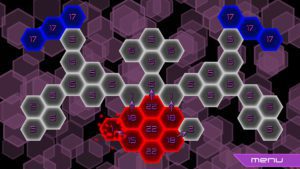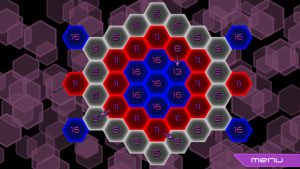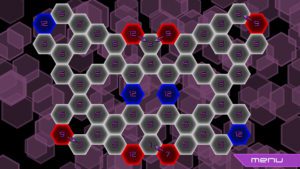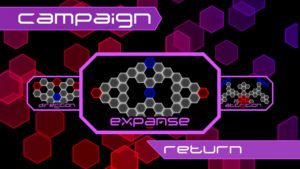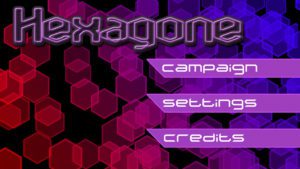 Hexagone is an action-strategy game for Android and iOS. This game represents my efforts at reducing gameplay into the simplest of concepts and producing a polished set diverse set of gameplay challenges from a simple ruleset.
Hexagone is an action-strategy game for Android and iOS. This game represents my efforts at reducing gameplay into the simplest of concepts and producing a polished set diverse set of gameplay challenges from a simple ruleset.
Overview – Project Details
Development Time: 3 Weeks
Platform: Android
Roles: Designer, Programmer, Artist
Tools: Corona SDK, Lua, Photoshop, Hexographer
Gallery – Screenshots
Video – Gameplay
Overview – Synopsis
For me, one of the most interesting problems to solve is simplifying mechanics down to their absolute minimum. Cut out as much complexity as possible, and see what you can build with the most basic mechanics. Hexagone is a game of force projection and territory control. The only action the player has is to direct a tile to project its force to an adjacent tile. The more tiles controlled, the greater the player’s ability to project force. From this simple ruleset, I created a series of short levels that teach the player different strategies and concepts, culminating into fast-paced action.
I took this opportunity to also refine and improve the mobile UX systems I had implemented in my last project, Solenia. Menus and screens are animated, and provide good visual and aural feedback. Gameplay transitions smoothly from one level to the next. And the title runs well on multiple platforms – Android and iOS.
This project was a fantastic learning experience for me. I was able to learn more about creating a simple and effective UX that provides good feedback to the user. This was also my first experience creating an iOS app, and learning that process has been invaluable.
Details – Design Process
I like to begin my design process by paper prototyping, but this mechanic didn’t really lend itself well to that medium. I found it far more effective to just implement the basic concept on a map, and play with it on a real device. When I did this, a few things became clear. First, there will be a physical limitation on the number of tiles that can be present. On a cell phone screen, the player’s finger will occupy a certain amount of space, and tiles should not be smaller than that, lest accuracy become a problem. This would dictate the design of maps, and the flow of resources from tile to tile.
Second, barring some very complicated AI, it was clear the player is going to be able to make much more intelligent move decisions. But even a very dumb AI can win if it’s allowed to make moves faster than a human is physically able to. So it was not necessary to create a complex AI. Simply by adjusting the rate at which the AI attacked and reinforced its own tiles, and the rate at which tiles generate new forces, the difficulty of any map can be greatly raised or lowered, and the player will never be aware the AI has not gotten any smarter or dumber.
At this point, the process was simply to create maps, playtest them, and tweak them. And playtest some more. And then find new people, and playtest with them. And then go someplace else, and find even more new people to playtest with. Playtesting was absolutely essential to creating a good series of training maps, and crafting a good difficulty curve. (Playtest!)
Details – UX Design
The biggest thing I wanted to do in terms of UX was to make the menus and buttons really polished. This is one of the biggest things that can be done to make a game feel really good. A simple button might have a different color or image when it’s being pressed, and maybe make a sound. But there can be much more feedback given to the player with a few simple animations.
In Hexagone, menu elements appear by sliding in from the sides of the screen. When a button is pressed, other buttons slide back off the screen, before the pressed button fades away. It’s a small thing, but it gives the interface a much more polished feel.
During gameplay, I initially had a single color for each side. During playtesting, players complained it was difficult to judge what move to make next, because they had to keep reading the number value of each tile. I addressed this problem by making a tile brighter when it has more units. From a glance, it’s now easy to assess the strength of any region, and decide where to focus one’s attention.

Details – Post-Mortem
Hexagone was a nice little game. But it was screaming for multiplayer. After this version was completed, I actually made a new version that utilized Corona’s brand new cloud-based multiplayer framework. It had online leaderboards and achievements. I was really proud of that version. Unfortunately, Corona Labs later decided to abandon their cloud initiative, rendering my improved version of the game inoperable. This was actually the greatest learning experience of this project. I based my entire project around a single new technology, and when that untried technology failed, I reaped the consequences.
I’m actually remaking this entire project right now in my spare time. The Corona graphics engine is now much more powerful than when I initially wrote this game, and there are a few different cross-platform multiplayer solutions available that did not exist at the time.
Download – Full Game
The full game is available as an apk, which can be installed on an Android device. Click here to download.
Because Hexagone is not on the Apple App Store, the iOS version is unavailable at this time.

